

It may be convenient to use disposable makeup removing wipes, and it’s simple to purchase a mega bag of cotton balls, but what impact does that place on the environment? How is your beauty routine un-green?
Mama, don’t fret that your current habits are unfriendly to the environment. You don’t need to throw convenience out the window, expand your budget, or forgo beauty altogether. Here are 4 tips to reduce your beauty waste and make your existing beauty routine more green!
Tip #1: Replace disposable makeup removing wipes with a microfiber towel.
After a long day, it’s easy to crash on the couch or move like a zombie towards bed. Don’t forget the importance of washing your face before you go to sleep! Remove the impurities of excess oil, dirt and grime (and the lovely additions of drool, sneeze germs, or remnants of little sticky fingers left behind by your children).
If you’re currently using disposable makeup removing wipes, consider saving the earth. Apparently those wipes take up to 100 years to decompose. What’s the alternative? A microfiber washcloth.
- The fibers of a microfiber cloth are finer than human hair, which allows the fabric to penetrate tiny spaces (like your pores) much more effectively than other cloths.
- Microfiber absorbs up to 8 times its weight, meaning it has the capacity to pull out and soak up excess oil from your skin.
- Additionally, microfiber can reduce bacteria by up to 99%. Bye-bye acne!
- Bonus: they also absorb less water than traditional washcloths, saving you money on your water bill.
This magical microfiber washcloth will remove all of your makeup, even waterproof mascara, with just water. Don’t believe me? Try for yourself! Here’s how to use a microfiber washcloth:
- Wet the cloth with warm water.
- Lightly squeeze out extra water.
- Wipe face, concentrating on areas that are heavy with makeup or excessively dirty.
- Repeat steps 1-3.
- Rinse off washcloth with 1 drop of soap and allow to dry.
We recommend Jane Iredale’s Magic Mitt or Campanelli Fresh Face Makeup Remover Towels.
Tip #2: Replace disposable cotton balls/rounds with flannel ones.
Perhaps you don’t use disposable makeup wipes (yay!). You probably use cotton balls or pads in your daily beauty routine. Most women apply makeup remover or face toner to a cotton pad and swipe over their face and neck at least once per day, sometimes twice. And these are the handiest when you need to remove makeup, apply alcohol to infected earring holes or a new pair of earrings, and even come in handy cleaning up children’s boo-boos.
Stop using those puffs and discs of cotton. Instead, use reusable cotton pads. These products are two or three layers of cotton sewn together into a round disc. Use them as you would use a cotton ball or pad, except don’t ditch them into the trash can when you’re done. They can be washed and dried in a mesh laundry bag, giving them a lifetime of up to 1000 washes.
For less than $15, you can have reusable and earth-friendly cotton balls that will last until you’re an empty nester (assuming you wash these once per week, for approximately 1000 weeks, which equates to 19 years).
We recommend wegreenco Natural Cotton Reusable Rounds or ProCIV Reusable Cotton Pads.
Tip #3: Replace disposable feminine products with reusable fabric pads or a menstrual cup.
Our friend “Aunt Flo” comes to visit almost every month and she can be a costly guest. That means women cycle through over 450 periods in her lifetime, an accumulative time of 6.25 years.
You’re throwing away piles and piles of used plastic pads and tampon applicators into the landfill, and swabs upon swabs of cotton into the water system. The Huffington Post did a cost breakdown in 2015 to elaborate just how expensive Aunt Flo can be:
- If you use one tampon every 6 hours, that’s 4 tampons per day.
- If your period lasts for 5 days, that’s 20 tampons per monthly cycle.A box of 36 tampons costs roughly $7 per box.
- Assuming you have 456 periods in your lifetime (the average), you’ll go through 253 total boxes of tampons in your lifetime.
- That’s a whopping total of $1,773.33.
And that doesn’t include the cost of pads, pantyliners, or new underwear (because we’ve all thrown away pairs of underwear that are beyond salvageable). Imagine all of those feminine products suffocating the Earth’s landfills.
What’s a girl to do to save her pocketbook and the Earth at the same time? Switch to reusable fabric pads or a menstrual cup.
You might be thinking, “Ew, a reusable fabric pad?” It’s better, and honestly more comfortable than you can imagine. It’s made with the same fabrics as cloth diapers. Soft, flannel cotton or bamboo on the outside (which is mighty soft and gentle on your delicate bits), with a core absorbent layer and a waterproof backing to prevent leaks.
How’s the cleanup? Not that messy. Rinse in the bathtub, and then wash with your towels.
And there are endless options to fit your body shape and preference. Snap buttons allow you to customize the gusset, and you can select your preferred length and shape when you purchase. They even make thin pantyliners and thong-shaped pads!
Similarly, menstrual cups are excellent replacements for tampons. They’re probably even better because they can remain in place for up to 12 hours! The worst part is having to reach inside to insert and remove the cup.
Cleaning the cup also isn’t as gross or messy as it sounds. Rinse with water in between uses, and boil in between cycles. The end. No dry cotton up in your business or the landfills.
P.S. We’ve heard rumors about a reusable tampon applicator. We haven’t tried it before, but comment below if you have any insight!
We recommend the Lena or Blossom menstrual cups, and WeeEssentials fabric pads.
Bonus Tip: Stop buying brand new bottles of hand soap. Reuse an existing soap pump, make your own liquid hand soap, and save money!
Every time you run out of hand soap, what do you do? Toss the old bottle out and purchase a new one. But what if you could make your own liquid hand soap in that same bottle for a fraction of the cost?
- You can purchase a 16 fl oz bottle of Dr. Bronner’s liquid castile soap from Target for $9.99.
- One homemade refill of soap requires 1 tablespoon of castile soap, which is ½ fl oz.
- From that 16 fl oz bottle of castile soap, you can make 32 bottles of homemade hand soap.
- That equals $0.31 cents per homemade bottle of hand soap.
Curious to learn more? Here’s how you can make your world greener with homemade liquid hand soap!
- Fill your bottle with water, leaving space at the top for the soap.
- Add in 1 tablespoon of castile soap, then mix well. (If you add your castile soap first, you will end up with a bubbly mess! Be sure to first add the water, then the soap.)
Option: If you want to add essential oils, first mix together your desired oils with an emulsifier, such as witch hazel. Then add in the water, and lastly the castile soap.
Tip: You must first mix the oils with an emulsifier so that the water and oils will blend together.
Green up your beauty routine, and save money too!
Help make our planet greener by simplifying your beauty routine. It will also save you money and be kinder to your skin!
Other Helpful Articles: